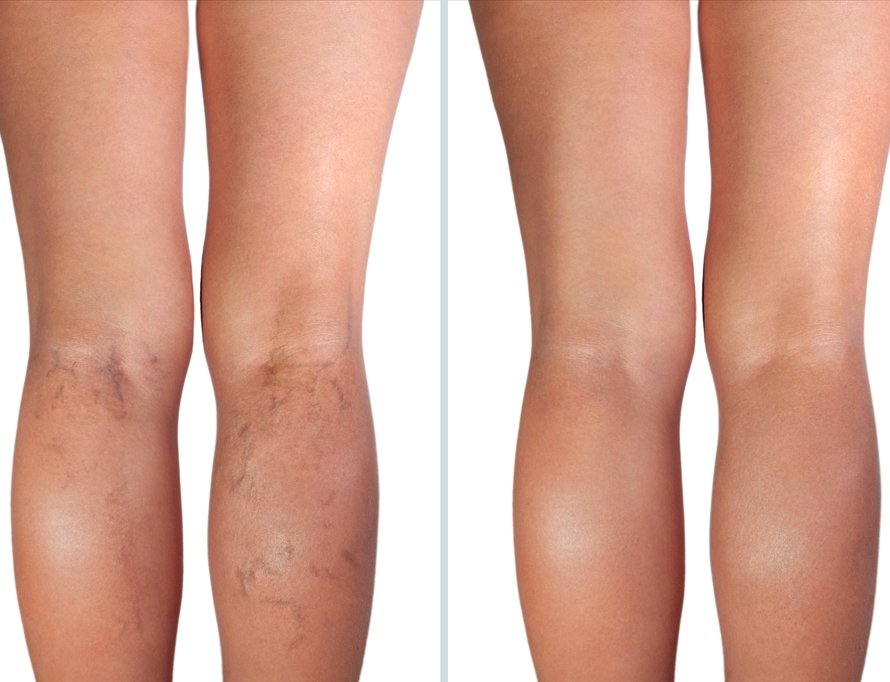(not available from June to September)
Vascular and Pigmentation Removal
* From $70
*Please contact us for more information on pricing.
FAQs
-
During a laser vein removal treatment, a concentrated beam of light energy from the laser is directed precisely at the small blood vessels.
The light penetrates below the surface of the skin and the heat causes the blood within the tiny vessels to coagulate.
The walls of the vein collapse, blood flow is stopped and over the next two to eight weeks the vein is absorbed into the body and disappears.
Blood flow will then be redirected to veins deeper below your skin’s surface where it should be.
-
Lasers are beams of light that vaporize the outer layers of your skin and promote the growth of new collagen fibers.
The energy of the laser is absorbed by the water content in the skin cells and the tissue can be vaporized. This causes the skin treated to shrink, stimulating the production of new collagen in the dermis.
The overall result is that new skin forms which are smoother and tighter.
Laser treatment for pigmented lesions like moles works by targeting the melanin pigment found within the melanocytes of the moles. It also works by destroying the pigment in the skin without the need for excision. This process is completed in 3 simple steps:
Step 1 – LIGHT ABSORPTION: The laser produces short nanosecond pulses of intense light that pass harmlessly through the top layers of the skin to be selectively absorbed by the melanin pigment in the lesion.
Step 2 – PIGMENT BREAK-UP: The laser light is transformed into photoacoustic waves which mechanically break up the melanin pigment into smaller particles.
Step 3 – PIGMENT REMOVAL: These particles are then removed by the body’s own immune system, as the skin’s macrophages clear the excess pigment from the area
-
Milia, which are small, white bumps, may appear in the laser-treated areas during healing (up to a month after treatment). These may be removed by gentle cleansing with a wash cloth.
Hyperpigmentation, and more rarely, hypopigmentation, may result in the laser-treated areas. In general, the hyperpigmented areas may be treated with bleaching cream to speed fading of the pigment. In addition, you should use broad-spectrum sunscreens for weeks before and after the treatment to prevent pigmentary changes.
You should expect swelling after laser skin resurfacing. Oral medications can help swelling around your eyes if needed.
Scarring after laser skin resurfacing, although very rare, may occur in laser-treated areas.
-
You should see an immediate difference in your treated skin. Depending on the laser treatment, your skin may stay pink or red for a few months. Your skin may continue to improve up to a year and the improvement may last for several years.
Normal aging will eventually lead to new wrinkles, which can be treated with laser resurfacing again.
You should avoid the sun as much as possible and apply sunscreen every day.
-
After Treatment:
Immediately after treatment, your skin will be red and feel sensitive and sunburned. Redness, swelling, itching or stinging may last for a few days. Don’t scratch or pick at skin that crusts as this can cause scarring or lead to an infection.
Five to 7 days after laser resurfacing, your skin will become dry and peel. Your new skin will at first appear pink. It should begin to gradually lighten up over the next two to three months
Cleanse the treatment area two to five times a day as instructed by your doctor.
Sleep on an extra pillow at night to help reduce the swelling for the first four days after the procedure.
Apply a cool compress or a wrapped ice pack for 15 minutes every one to two hours as needed, during the first 24 to 48 hours.
Apply a thin layer of petroleum jelly (or any occlusive moisturizer) or antibiotic ointment (such as bacitracin) to the area twice a day until the skin heals.
Avoid aggressive facial treatments, such as tretinoin or glycolic acid for four weeks and any topical products that may cause irritation for six weeks following treatment.
Avoid activities that can cause flushing for two weeks after treatment.
Don’t smoke. Smoking slows the healing process.
After healing:
Apply a daily broad-spectrum (screens both ultraviolet B and ultraviolet A rays) sunscreen after healing to protect your newly laser-resurfaced skin. A sunscreen specifically formulated for use on the face should be chosen, with a sun protection factor (SPF) of at least 30.
Apply daily moisturizer as recommended by your medical asthetic technician. We strongley recommend the use of sunscreen post-treatment, regardless of the time of year, as harmful UV rays are present even during the winter months. UV rays are also present with the use of technology such as cell phones, computer screens and televisions.
Our Medical Aestheticians and Front Desk staff can assist in selecting the sunscreen best suited for you, as we have an array of options from which to choose.




